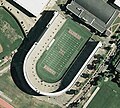Portal:College football
The College football Portal
College football is gridiron football that is played by teams of amateur student-athletes at universities and colleges. It was through collegiate competition that gridiron football first gained popularity in the United States.
Like gridiron football generally, college football is most popular in the United States and Canada. While no single governing body exists for college football in the United States, most schools, especially those at the highest levels of play, are members of the NCAA. In Canada, collegiate football competition is governed by U Sports for universities. The Canadian Collegiate Athletic Association (for colleges) governs soccer and other sports but not gridiron football. Other countries, such as Mexico, Japan and South Korea, also host college football leagues with modest levels of support.
Unlike most other major sports in North America, no official minor league farm organizations exist for American football or Canadian football. Therefore, college football is generally considered to be the second tier of American and Canadian football; ahead of high school competition, but below professional competition. In some parts of the United States, especially the South and Midwest, college football is more popular than professional football. For much of the 20th century, college football was generally considered to be more prestigious than professional football.
The overwhelming majority of professional football players in the
Selected article
The 1986 Peach Bowl was a post-season American
Virginia Tech came into the game with a 9–1–1 record that included an unusual win over the Temple Owls, who were forced to forfeit a victory to Virginia Tech after using an ineligible player. Facing the Hokies in the Peach Bowl were the 18th-ranked Wolfpack from North Carolina State University. N.C. State was led by head coach Dick Sheridan and had a regular-season record of 8–2–1 that included five wins over Atlantic Coast Conference teams.
The 1986 Peach Bowl
NC State, needing to score, drove down the field and kicked a go-ahead 33-yard field goal with 7:12 remaining in the game. After a failed possession, Tech was forced to punt the ball, allowing NC State to run down the clock. The Virginia Tech defense eventually forced a stop, giving the Tech offense one final chance to win the game. With 1:53 on the clock and beginning from their own 20-yard line, the Hokies drove 57 yards to the NC State 23-yard line. There, kicker Craig Kinzer successfully kicked a 40-yard field goal as time expired to give Virginia Tech the win.
Quotes
- We need a playoff. — NCAA Division I-A
- I like to believe that my best hits border on felonious assault. — former Ohio State Buckeyes defensive back Jack Tatum, on the fierce quality of his play
- If anything goes bad, I did it. If anything goes semi-good, we did it. If anything goes really good, then you did it. That's all it takes to get people to win football games for you. — Paul "Bear" Bryant, on his motivationaltechniques
- When people used to see Wake Forest on the schedule, they used a pen to mark down a `W.' We're at the point now where we at least make them use a pencil. — Wake Forest head coach Jim Grobe
Did you know...
- ... that the NCAA Division I footballhistory?
- ... that I-AArecords?
- ... that Vanderbilt's "Blonde Bear" supervised the ransacking of black households in the 1946 Columbia Race Riot?
- ... that Native American football player Peter Hauser has been credited with throwing the first spiral pass?
- ... that the national championships and ranks second in wins in college footballhistory?
- ... that African-American player for the Green Bay Packers?
- ... that Deputy National Security Advisor Denis McDonough played for Hall of Fame football coach John Gagliardi at Saint John's University?
- ... that the Division III college footballteam?
Selected image
Calendar
| Dec 9 | Army–Navy Game | Army vs Navy |
| Dec 29 | Cotton Bowl Classic | #7 Ohio State vs #9 Missouri |
| Dec 30 | Peach Bowl | #10 Penn State vs #11 Ole Miss |
| Orange Bowl | #5 Florida State vs #6 Georgia | |
| Jan 1 | Fiesta Bowl | #8 Oregon vs #23 Liberty |
| Rose Bowl | #1 Michigan vs #4 Alabama | |
| Sugar Bowl | #2 Washington vs #3 Texas | |
| Jan 8 | College Football National Championship | #1 Michigan vs #2 Washington |
| 2023 season: FBS (Bowl games) • FCS • D-II • D-III | ||
|---|---|---|
WikiProjects
Subcategories
College football topics
Sports portals
Associated Wikimedia
The following Wikimedia Foundation sister projects provide more on this subject:
-
Commons
Free media repository -
Wikibooks
Free textbooks and manuals -
Wikidata
Free knowledge base -
Wikinews
Free-content news -
Wikiquote
Collection of quotations -
Wikisource
Free-content library -
Wikiversity
Free learning tools -
Wiktionary
Dictionary and thesaurus












